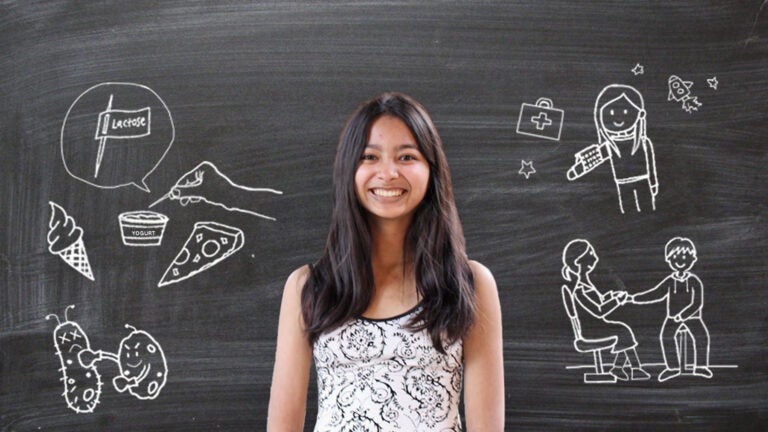
Nina Singh entered college early and has found success in her studies at USC. (Illustration/Courtesy of Suha Park)
From high school ‘dropout’ to budding biomedical engineer
Teenager skips her senior year in Northern California to focus on USC research that could make us healthier
At 16, Nina Singh did what most people her age are told not to do: She dropped out of high school.
But that decision to leave Oakwood School in Santa Clara County came with a twist.
During the summer of 2014, Singh received an invitation to apply to USC’s Resident Honors Program, a specialized program in which 20 to 30 high school juniors with the maturity to enter college early have the chance to skip their senior year of high school and attend USC.
Before receiving the invitation, Singh had never considered entering college early, but once it arrived, she knew she wanted to enter a more dynamic and innovative intellectual environment and immediately applied.
Currently finishing her freshman year in biomedical engineering with an emphasis in biochemical engineering, Singh has focused her energy on research and its practical applications in helping people live healthier lives.
CHIP shot
As a member of the USC Community Health Improvement Project (CHIP), a student club that promotes health awareness around the community, Singh has been involved in blood glucose and blood pressure screenings around Los Angeles.
While screenings are meant to help patients and promote health care, she sees a research opportunity. By collecting blood glucose data and analyzing that data to see if certain demographic groups show patterns of higher or lower risk levels, Singh hopes specialized data can one day help people recognize their health risks, prevent disease and hopefully save lives. The majority of CHIP students are pre-med, but by combining both specialties, Singh sees possibilities to help even more people.
“The coolest things happen,” she said, “when you combine perspectives.”
Make it or break it
Singh is happy that USC has provided her with the challenge and hands-on opportunities she craved in high school.
During Makeathon, a recent design competition in which students are tasked with designing a medical device that solves a challenge, she was part of a team that won third place for its design of a splint that can help astronauts injured in space. That was her first engineering design project, and she said, “It was a lot of fun and made it clear how much I really liked engineering.”
The splint is small, lightweight and can be adapted to a specific injury, allowing for astronauts to travel with splints without worrying about space and weight constraints.
Singh is always thinking about ways to engineer creatively. At the end of her first semester at USC, she won a $1,000 prize during SparkSC’s 1,000 Pitches competition, where she pitched the idea of a toothpick that could detect allergens in food.
“My brother is allergic to a lot of different foods,” she said, “so I thought a toothpick that changed colors based on individual allergens would be really cool.”
It’s just an idea at this stage, but combined with her experience of designing the Sam Splint 2.0, she has seen engineering’s creative side and may one day consider working for a biotech company or developing her own products.
Lab work
Singh currently works at USC’s Eliasson Lab and continues to collaborate with two labs at UCLA to do mechanical engineering, literature reviews and biomathematics research, respectively. She also serves as director of research for GLIA, a soon-to-launch nonprofit focused on combatting depression through community-based approaches, works as an application specialist for College Zoom and is a future co-editor-in-chief of USCience Review. She also recently was first author on a literature review published in the science journal PLOS ONE. The article — “How Often Are Antibiotic-Resistant Bacteria Said to ‘Evolve’ in the News?” — analyzed how often the word “evolve” was used when describing bacteria. Published as first author in a peer-reviewed science journal is a feat many accomplish later in their academic careers, if at all, but Singh already has plans for another paper in the works.
For now, she’ll spend her summer developing a gradient sequential pneumatic pump with the Ginger-K Lymphedema and Cancer Care Center, continuing to work on long-distance research and improving her cooking, painting and writing skills — just a few more things in her bid to become a better engineer.



